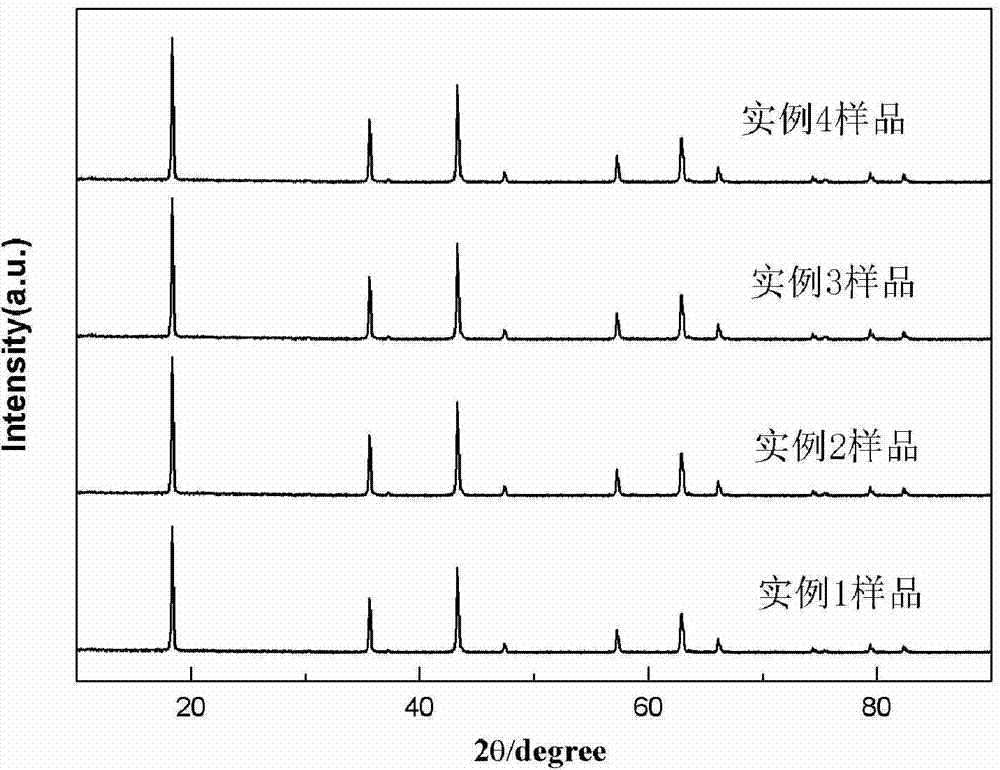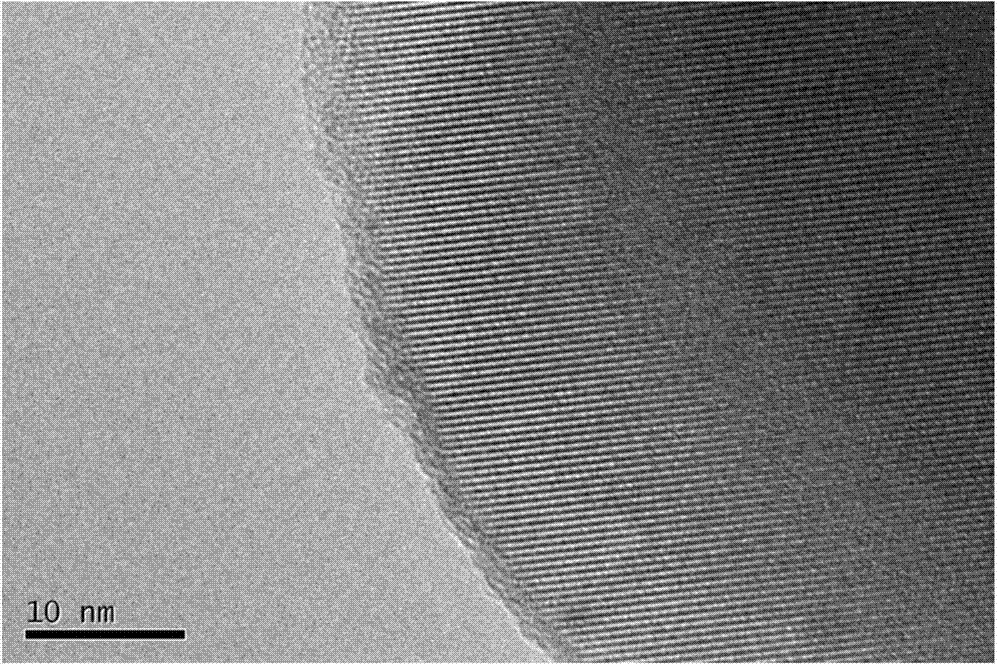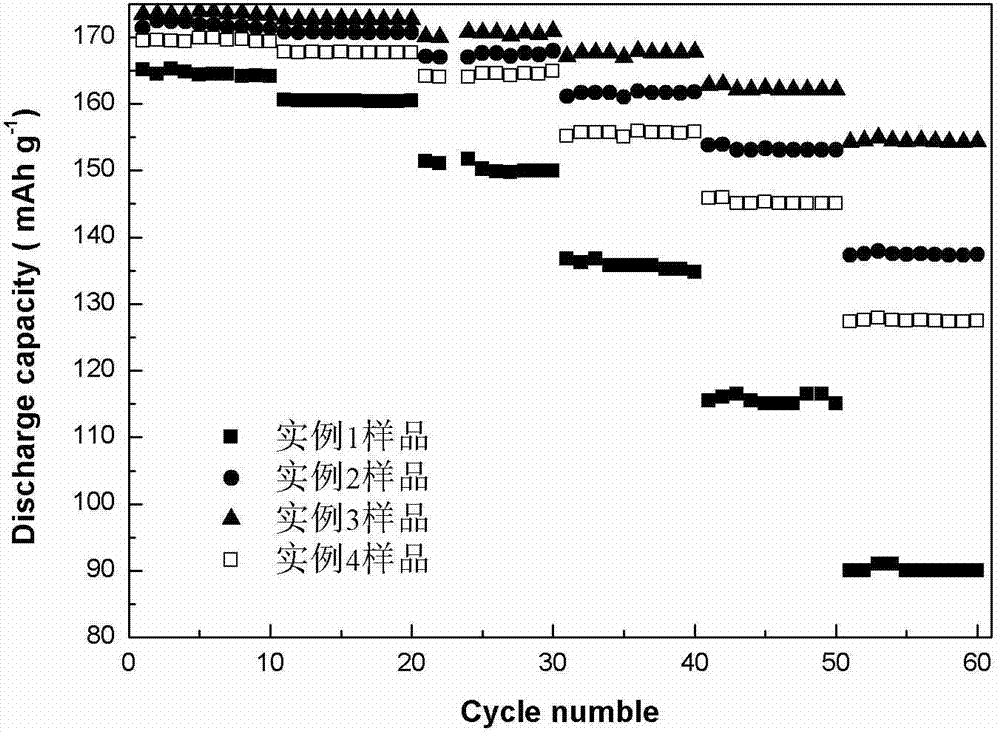Method for preparing vanadium trioxide coated lithium titanate negative electrode material
A technology of vanadium trioxide coating lithium titanate and negative electrode materials, which can be applied to battery electrodes, electrical components, circuits, etc., can solve problems such as poor electronic conductivity, achieve high rate performance, uniform grain distribution, and good cycle performance Effect
- Summary
- Abstract
- Description
- Claims
- Application Information
AI Technical Summary
Problems solved by technology
Method used
Image
Examples
Embodiment 1
[0024] Li 4 Ti 5 o 12 Preparation of negative electrode materials
[0025] Weigh 0.06mol of lithium acetate and 1.5g of polyvinylpyrrolidone (PVP), dissolve them in 500mL of distilled water; add 0.075mol of nano-titanium dioxide, and stir magnetically for 1 hour to obtain a slurry; spray dry the slurry at 110°C to obtain a lithium titanate precursor ; The lithium titanate precursor was calcined at 750° C. for 8 hours in an air atmosphere to obtain a pure lithium titanate negative electrode material. X-ray diffraction pattern see figure 1 .
Embodiment 2
[0027] 1% V2O3 coated Li 4 Ti 5 o 12 Preparation of negative electrode materials
[0028] Weigh 0.06mol of lithium acetate and 1.5g of polyvinylpyrrolidone (PVP), dissolve them in 500mL of distilled water; add 0.075mol of nano-titanium dioxide, and stir magnetically for 1 hour to obtain a slurry; spray dry the slurry at 110°C to obtain a lithium titanate precursor ; The lithium titanate precursor was roasted at 750°C for 8 hours in an air atmosphere to obtain a pure lithium titanate negative electrode material; weighed 0.109g ammonium metavanadate and 0.01mol glycine, dissolved in 500mL distilled water; added pure lithium titanate negative electrode Materials, magnetically stirred for 1h; after evaporating the solvent at 100°C, vacuum drying at 80°C for 1h to obtain the vanadium trioxide-coated lithium titanate precursor; the vanadium trioxide-coated lithium titanate precursor was Calcining at 600° C. for 6 h to obtain a negative electrode material of vanadium trioxide-coat...
Embodiment 3
[0030] 2% V2O3 coated Li 4 Ti 5 o 12 Preparation of negative electrode materials
[0031] Weigh 0.06mol of lithium acetate and 1.5g of polyvinylpyrrolidone (PVP), dissolve them in 500mL of distilled water; add 0.075mol of nano-titanium dioxide, and stir magnetically for 1 hour to obtain a slurry; spray dry the slurry at 110°C to obtain a lithium titanate precursor ; The lithium titanate precursor was roasted at 750°C for 8 hours in an air atmosphere to obtain a pure lithium titanate negative electrode material; weighed 0.220g ammonium metavanadate and 0.01mol glycine, dissolved in 500mL distilled water; added pure lithium titanate negative electrode Materials, magnetically stirred for 1h; after evaporating the solvent at 100°C, vacuum drying at 80°C for 1h to obtain the vanadium trioxide-coated lithium titanate precursor; the vanadium trioxide-coated lithium titanate precursor was Calcining at 600° C. for 6 h to obtain a negative electrode material of vanadium trioxide-coat...
PUM
 Login to View More
Login to View More Abstract
Description
Claims
Application Information
 Login to View More
Login to View More - R&D
- Intellectual Property
- Life Sciences
- Materials
- Tech Scout
- Unparalleled Data Quality
- Higher Quality Content
- 60% Fewer Hallucinations
Browse by: Latest US Patents, China's latest patents, Technical Efficacy Thesaurus, Application Domain, Technology Topic, Popular Technical Reports.
© 2025 PatSnap. All rights reserved.Legal|Privacy policy|Modern Slavery Act Transparency Statement|Sitemap|About US| Contact US: help@patsnap.com



